Comprehensive Checklist of What Data Is Google Analytics Goals Unable to Track
Comprehensive Checklist of What Data Is Google Analytics Goals Unable to Track
Blog Article
Discover the Limitations of Google Analytics Goals: Introducing the Information Kind That Remain Untrackable
As businesses progressively depend on data-driven decision-making, understanding the constraints of tools like Google Analytics becomes extremely important. While Google Analytics Goals offer useful understandings right into customer communications, there exist data types that avoid tracking, posturing difficulties to a comprehensive understanding of user behavior. These untrackable information kinds elevate questions about the accuracy and efficiency of the analytics information that organizations heavily trust for their digital methods. Interested to uncover the surprise blind areas in your information analysis procedure?
Insufficient Customer Trip Tracking
Insufficient customer trip monitoring within Google Analytics can prevent the ability to precisely analyze customer actions. When the user journey is not fully tracked, there are gaps in the information that protect against a detailed understanding of exactly how customers engage with a site. This lack of insight can lead to missed out on possibilities for optimization and renovations to the individual experience.
One typical problem with incomplete individual journey monitoring is the inability to see the complete path that users take before finishing a goal or leaving the site. Without this information, it is testing to determine where individuals may be coming across barriers or rubbing points that prevent them from transforming. Additionally, insufficient monitoring can obscure the impact of specific advertising efforts or website changes on individual behavior.
To address this limitation, it is crucial to establish appropriate monitoring devices within Google Analytics to capture the whole user trip. This might include setting up occasion monitoring, objective funnels, or using tools like Google Tag Supervisor to make certain that no crucial interactions go unrecorded. By obtaining a thorough sight of the customer journey, website proprietors can make more enlightened decisions to enhance customer interaction and drive conversions.
Acknowledgment Obstacles
Navigating through attribution difficulties in Google Analytics calls for a detailed understanding of exactly how different touchpoints add to the total conversion procedure. Acknowledgment difficulties emerge from the intricacy of contemporary consumer journeys, where users communicate with multiple networks before converting.
One usual acknowledgment challenge is the problem in associating conversions to the appropriate resource, particularly in situations where users engage with multiple channels prior to transforming. Additionally, cross-device tracking postures another attribution obstacle, as users often switch between gadgets during their trip, making it challenging to track their communications effortlessly.
Offline Conversions
Offered the obstacles related to connecting conversions precisely in online networks, the measurement of offline conversions offers a considerable possibility for marketing professionals looking for a more detailed understanding of their customers' journey. Offline conversions describe actions that clients absorb the real world, such as making acquisitions in brick-and-mortar stores or over the phone, going to events, or involving with published materials - what data is google analytics goals unable to track. These conversions are vital for companies that run both online and offline, as they supply important insights into the performance of marketing projects throughout numerous touchpoints
Tracking offline conversions generally posed a considerable obstacle for online marketers, as it was testing to link these activities back to details online communications accurately. However, with developments in modern technology, such as the assimilation of CRM systems, unique identifiers, and coupon codes, organizations can now bridge the gap between online and offline information to gain an extra all natural view of client habits. By successfully gauging offline conversions, marketing professionals can enhance their methods, assign resources a lot more effectively, and inevitably boost the total client experience.
Cross-Device Monitoring
Cross-device monitoring plays a critical function in comprehending the interconnected nature of consumers' digital communications across multiple devices. In today's omnichannel globe, where customers effortlessly switch in between mobile phones, tablets, and desktop computers, tracking their actions across these tools is essential for marketers to obtain an extensive sight of their customer journey.

In addition, privacy issues and laws such as GDPR and CCPA have further complex cross-device tracking. With users requiring more control over their information and boosted constraints on monitoring modern technologies, marketing professionals must find privacy-compliant and innovative means to attach customer interactions throughout gadgets.
Dynamic Content Interaction
Comprehending user interaction with dynamic content is pivotal in optimizing digital marketing strategies for boosted audience interaction. Dynamic web content describes web site aspects that alter based on user behavior, choices, or various other elements, supplying a customized experience. Tracking user communications with dynamic content positions difficulties for standard analytics devices like Google Analytics.
While Google Analytics can track standard communications like clicks and page sights, it might have a hard time to catch even more nuanced involvements within dynamic content. what data is google analytics goals unable to track. Metrics such as time invested in particular dynamic components, float actions, or communications within pop-ups are usually not easily measurable using standard monitoring approaches. This constraint impedes marketing professionals' ability to fully realize exactly how customers are engaging with vibrant content and customize their techniques appropriately

Verdict
In verdict, Google Analytics objectives have constraints in tracking insufficient individual journeys, attributing conversions properly, recording offline conversions, tracking cross-device communications, and measuring dynamic web content involvement. These restraints highlight the value of exploring additional tracking methods and devices to gain a more extensive understanding of user habits and conversions past what Google Analytics can give.
While Google Analytics Goals deal important understandings right into individual interactions, there exist information types that elude tracking, positioning obstacles to an extensive understanding of customer behavior.Incomplete customer journey tracking within Google Analytics can prevent the capacity to accurately evaluate individual behavior. When the user trip is not fully tracked, there are gaps in the data that prevent an extensive understanding of how users interact with a site.One common problem with incomplete individual trip tracking is the failure to see the full course that users take previously completing a goal or leaving the site. By acquiring an extensive sight of the individual journey, site proprietors can make more informed decisions to improve user involvement and drive conversions.
Report this page